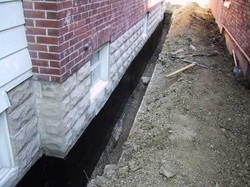The Advantages Of Basement Waterproofing

One of the challenges of many homeowners is basement waterproofing. It creates a domino effect problem if not done correctly. Basement waterproofing will let you do many things in your basement with the first one having a usable basement for whatever purpose you may decide.
The best time to do basement waterproofing is when the foundation is built. Waterproofing a basement efficiently when it is first built will ensure that it will last for a long time. This is also the best time to do basement waterproofing because it's much easier to get into small spaces before they are closed off due to constructions, such as corners and even areas where drainage pipes will be installed. If you got an old house, then you have to give the basement a very through check before deciding how to do the basement waterproofing. It will be wise to contact a professional when you do basement waterproofing so that you won't need to do it all over again because the basement waterproofing wasn't done correctly.
There are two ways to do basement waterproofing. These are external basement waterproofing and interior basement waterproofing. One of the common methods of external basement waterproofing is tanking. This refers to the process in which a bonding substance or membrane is applied to the outside walls of your basement. Make sure that the tanking takes place as your home is being constructed, especially if your basement is underground. Another way of external basement waterproofing is the outside drainage system. In this method, your basement will be built in such a way that the floors of the basement slope toward your home's sump pump. For quick removal of any moisture from your basement, a plastic honeycomb membrane is applied to the walls and floor of your basement. The French drain is also another method of external basement waterproofing. This form of basement waterproofing is usually installed on houses that are constructed in parts of the country with heavy rainfall levels and other types of moisture-based weather. External basement waterproofing method is the only one recognized by the International Building Code as efficient enough to keep water from doing any intense structural damage to a building or home.
Interior basement waterproofing is used to keep moisture from making its way into your basement. A sealant is applied on the walls and floor of the basement so that water and moisture can't seep through. It also keeps molds and mildew from growing. Interior Sealants aren't technically basement waterproofing materials, but they can help you make do while you are working on other waterproofing methods. For best results, it is recommended that you do both the external and interior basement waterproofing, just to make sure.
It is important to make sure that you do basement waterproofing because your basement forms the foundation of your house and if it is not in the best condition, it can jeopardize your entire house in the long run.
The best time to do basement waterproofing is when the foundation is built. Waterproofing a basement efficiently when it is first built will ensure that it will last for a long time. This is also the best time to do basement waterproofing because it's much easier to get into small spaces before they are closed off due to constructions, such as corners and even areas where drainage pipes will be installed. If you got an old house, then you have to give the basement a very through check before deciding how to do the basement waterproofing. It will be wise to contact a professional when you do basement waterproofing so that you won't need to do it all over again because the basement waterproofing wasn't done correctly.
There are two ways to do basement waterproofing. These are external basement waterproofing and interior basement waterproofing. One of the common methods of external basement waterproofing is tanking. This refers to the process in which a bonding substance or membrane is applied to the outside walls of your basement. Make sure that the tanking takes place as your home is being constructed, especially if your basement is underground. Another way of external basement waterproofing is the outside drainage system. In this method, your basement will be built in such a way that the floors of the basement slope toward your home's sump pump. For quick removal of any moisture from your basement, a plastic honeycomb membrane is applied to the walls and floor of your basement. The French drain is also another method of external basement waterproofing. This form of basement waterproofing is usually installed on houses that are constructed in parts of the country with heavy rainfall levels and other types of moisture-based weather. External basement waterproofing method is the only one recognized by the International Building Code as efficient enough to keep water from doing any intense structural damage to a building or home.
Interior basement waterproofing is used to keep moisture from making its way into your basement. A sealant is applied on the walls and floor of the basement so that water and moisture can't seep through. It also keeps molds and mildew from growing. Interior Sealants aren't technically basement waterproofing materials, but they can help you make do while you are working on other waterproofing methods. For best results, it is recommended that you do both the external and interior basement waterproofing, just to make sure.
It is important to make sure that you do basement waterproofing because your basement forms the foundation of your house and if it is not in the best condition, it can jeopardize your entire house in the long run.
